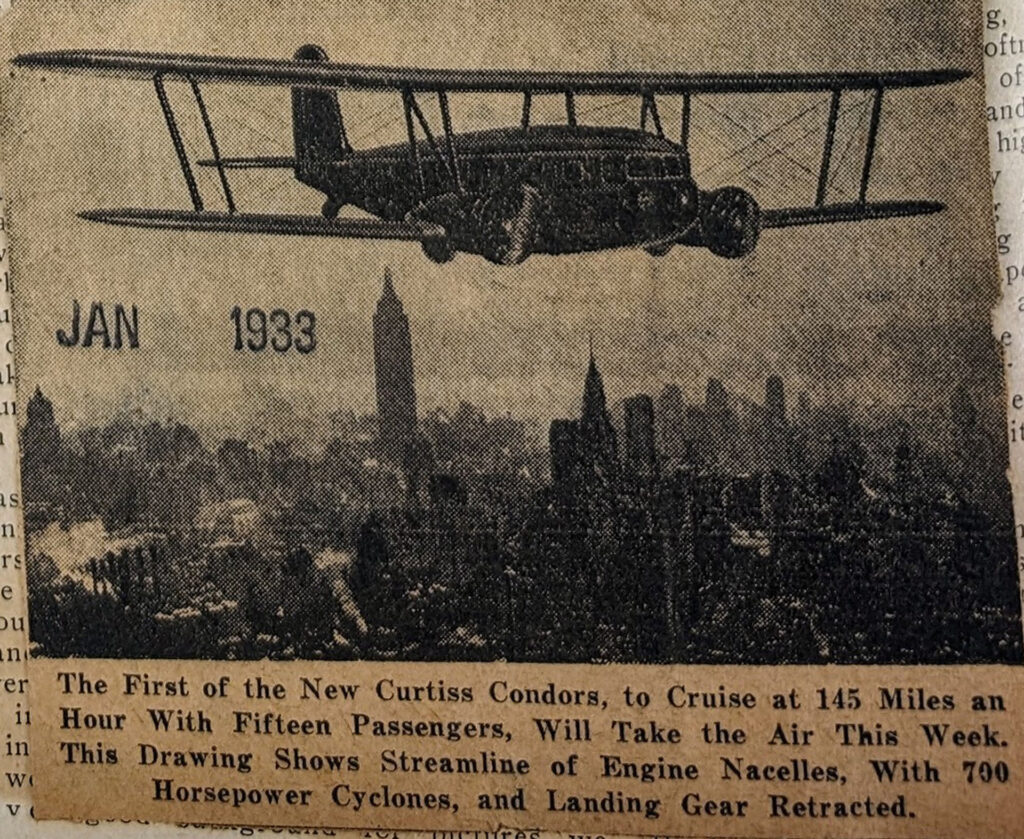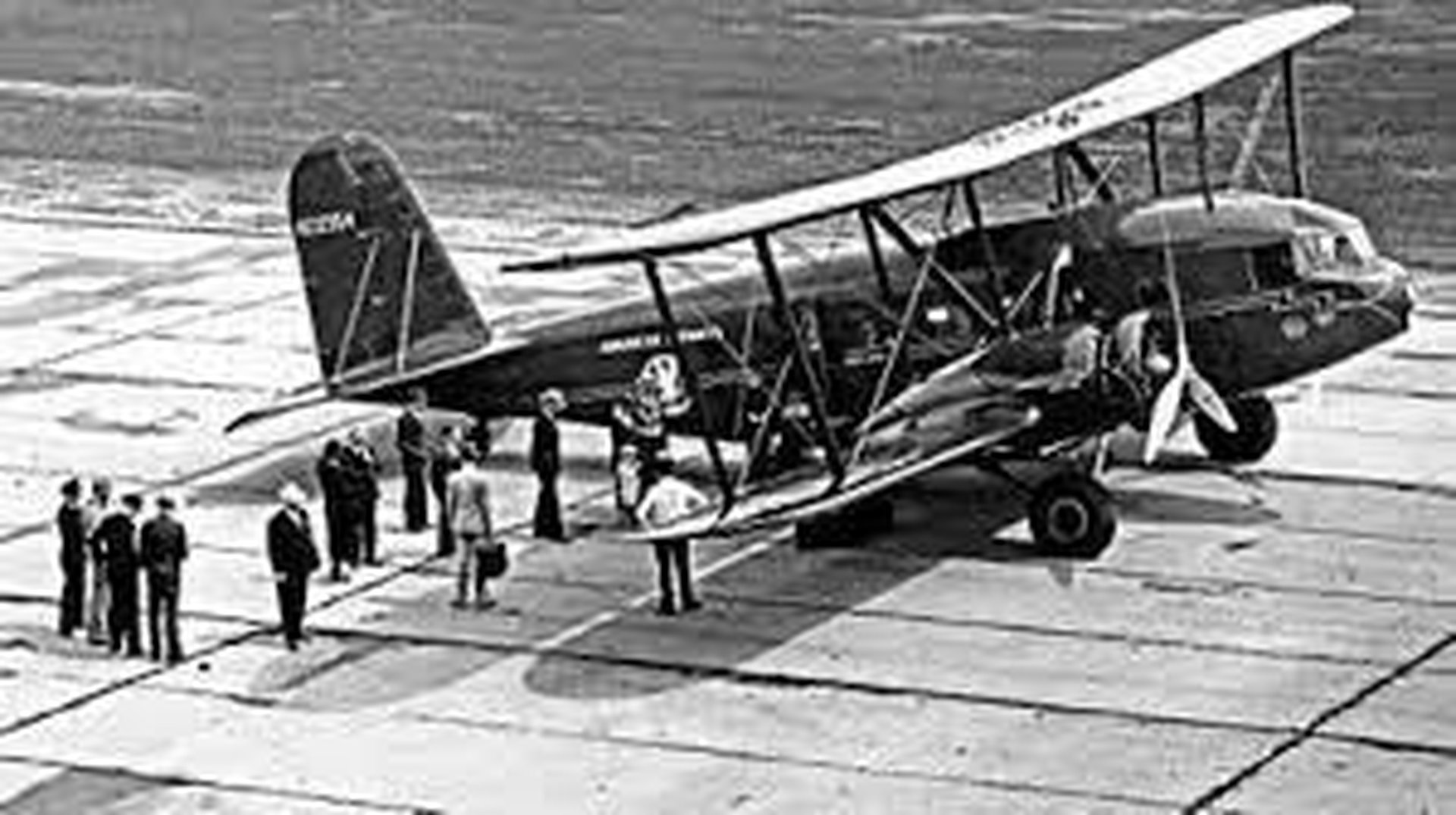Tony’s Scrapbook: Curtiss T-32 Condor II

This newspaper clipping above shows a Curtiss Condor, a biplane primarily used for civilian and military purposes during the late 1920s and early 1930s. Based on the clipping information, this model is a new version of the Condor, equipped with 700-horsepower Cyclone engines.
Aircraft Overview:
- Curtiss Condor (1930s version): The Curtiss Condor was designed as a large transport aircraft capable of carrying passengers. It was also used as a bomber and transport aircraft in military service.
- First Flight: The original Condor first flew in 1929, but by 1933, updated versions like the one in this clipping were in development.
- Passenger capacity: As mentioned, this aircraft could carry 15 passengers, a notable achievement for aircraft of this era.
- Speed and Performance: At a cruise speed of 145 miles per hour, the Curtiss Condor was relatively fast for its size. The powerful Wright Cyclone engines improved performance.
- Features: The text highlights retractable landing gear and streamlined engine nacelles, part of the design improvements to increase efficiency and speed.
In the early 1930s, airplanes like the Curtiss Condor were not just flying machines but pioneers in shaping the future of commercial aviation. They provided safer, faster, and more comfortable air travel, setting the stage for the next generation of transport aircraft, including all-metal monoplanes. The Curtiss Condor’s versatility, serving in various military roles for the U.S. Army Air Corps and other countries, further showcases its historical significance.
The skyline in the background, likely New York City, places this plane in the context of early American aviation growth. The Curtiss Condor played a significant role in this growth, connecting major cities like New York, Atlanta, Washington, D.C., Chicago, and Cleveland by air routes, revolutionizing early air travel.
The specific version of the Curtiss Condor I’m referring to in the 1933 clipping appears to be the Curtiss T-32 Condor II, an upgraded model of the earlier Condor series with advancements in performance and design.
Curtiss T-32 Condor II Overview:
- Engines: This version of the Condor was equipped with two Wright R-1820 Cyclone engines, each delivering 700 horsepower. These radial piston engines provided more power and efficiency than those used in the earlier Condor I.
- Aircraft Type: The Condor II was primarily designed as a commercial airliner but was also adapted for military transport roles. It could carry passengers or cargo over long distances with improved speed and reliability.
- Capacity: At the time, the civilian Curtiss T-32 was configured to carry up to 15 passengers in relative comfort. The fuselage was designed to provide an enclosed, heated cabin with luxurious amenities compared to earlier aircraft.
- Performance:
- Cruise Speed: The Condor II’s cruise speed was 145 mph, as mentioned in the clipping. This was relatively fast for an aircraft of its size and passenger capacity.
- Range: The plane’s range was approximately 750 miles, allowing for long-distance flights, which made it suitable for transcontinental or long intercity routes in the U.S.
- Landing Gear: One notable improvement over the previous models was the addition of retractable landing gear, which reduced drag and improved the aircraft’s overall aerodynamics, contributing to its higher cruise speed.
Design Features:
- Biplane Configuration: Despite the 1930s being a transition period toward monoplanes, the Condor II retained the traditional biplane design. However, its design was optimized for better performance, with refinements such as streamlined engine nacelles and more efficient wings.
- Comfort: The interior was designed to be more comfortable for passengers than previous aircraft, with reclining seats, soundproofing, and heating—luxury features during the early 1930s. This was in response to the growing demand for more passenger-friendly air travel.
- Material: The airframe still used a combination of materials, with some wood and fabric components. The move towards all-metal aircraft had begun but was not widespread, so the Condor II represented a transitionary design.
Military Use:
While the version in your clipping is likely a civilian variant, the Curtiss Condor II was also used for military purposes:
- Designation: This aircraft’s military transport variant was designated the Curtiss YC-30. Some air forces used it for troop transport, cargo delivery, and even as a light bomber.
- Users: Besides the U.S. Army Air Corps, the aircraft was sold to foreign air forces, including the Colombian Air Force and others, where it was used for military and civil transport duties.
The Curtiss Condor II played a crucial role in the evolution of aviation. It served as a bridge between the early days of aviation, characterized by biplane designs, and the more modern, streamlined aircraft that would follow in the late 1930s and 1940s. Despite its biplane configuration becoming outdated, the Condor II’s success helped keep Curtiss at the forefront of aviation innovation during the early 1930s.
In 1933, Eastern Air Transport, which later became Eastern Air Lines, primarily used the Curtiss T-32 Condor II for commercial passenger service. The aircraft flew on several prominent routes in the United States, linking major East Coast cities and key Midwestern destinations. These routes were crucial in establishing the viability of air travel as a means of long-distance transportation.
Primary Routes:
New York City to Miami:
- The New York to Miami route was one of Eastern Air Transport’s flagship routes. It was essential due to Florida’s growing popularity as a vacation destination, especially during the winter months.
- The Curtiss T-32 Condor II made the trip more comfortable and faster for passengers, with improved amenities like heated cabins.
New York City to Atlanta:
- Another significant route was between New York City and Atlanta, an emerging business hub at the time. This was a key route for both business travelers and tourists.
New York City to Washington, D.C.:
- The New York to Washington route was critical for government officials, diplomats, and business travelers, linking the political and financial capitals of the U.S.
- The Condor II was often used for this short but high-demand route.
New York City to Chicago:
- The route between New York and Chicago was one of the busiest and most important for commercial aviation in the 1930s. It connected the major financial centers of the East Coast with the Midwest.
- The flight would typically stop in Philadelphia, Pittsburgh, or Cleveland.
New York City to Cleveland:
- The connection to Cleveland was also significant, as it was a major industrial center in the early 20th century. Eastern Air Transport often flew this route, with the Condor II pivotal in providing service.
Other Routes:
Washington, D.C. to Miami:
- A continuation of the New York to Miami route, with stops in Washington, D.C., Atlanta, and Jacksonville. It served a growing number of affluent travelers heading to Florida for leisure.
Miami to Havana, Cuba:
- Some Condor II aircraft were also used on international routes, like the one connecting Miami to Havana, Cuba, a popular destination for American tourists.
Flight Characteristics:
- Flight Duration: Due to the relatively slow speeds by today’s standards, a trip from New York City to Miami could take over 10 hours, usually with multiple refueling stops. However, for its time, this was a significant improvement over train travel.
- Stopovers: Flights during this era typically involved several stopovers for refueling and maintenance, making multi-city connections essential. Popular stopover cities included Philadelphia, Washington, D.C., Richmond, Charlotte, Atlanta, and Jacksonville.
The T-32 Condor II helped define these early air routes, offering faster and more reliable service than previous aircraft. These routes supported business and tourism and helped solidify air travel as a mainstream mode of transportation in the U.S. by the mid-1930s.
Though the Condor II was soon replaced by more advanced aircraft like the Douglas DC-2 and DC-3, its use on these early air routes laid the groundwork for the airline industry’s rapid expansion throughout the 1930s and beyond.
I’m glad you made it to the end of another article I created from a single newspaper clipping that my father decided to save because it had meaning to him when he was fascinated with aviation in the early 1930s.
Things never change, and I’ll see you at the next one!
Discover more from Buffalo Air-Park
Subscribe to get the latest posts sent to your email.






